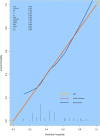A nomogram for reduced cardiac function in postoperative acute type A aortic dissection patients with acute kidney injury undergoing continuous renal replacement therapy
- PMID: 35942182
- PMCID: PMC9356236
- DOI: 10.3389/fcvm.2022.874715
A nomogram for reduced cardiac function in postoperative acute type A aortic dissection patients with acute kidney injury undergoing continuous renal replacement therapy
Abstract
Background: This study aimed to develop a nomogram to predict reduced cardiac function for acute kidney injury (AKI) patients who received continuous renal replacement therapy (CRRT) after acute type A aortic dissection (ATAAD) surgery.
Methods: This study was a retrospective analysis. ATAAD patients with preoperative normal ejection fraction (EF) and postoperative AKI with CRRT admitted between January 2014 and November 2021 were included. The reduced cardiac function was defined as EF <50%. The data were analyzed by the univariate and multivariate logistic regression analyses. A diagnostic model was established by a nomogram, and its discriminative performance was validated by the received operating characteristic (ROC) curve and concordance (C) statistic. The calibration of the diagnostic model was tested by calibration curves and the HosmerLemeshow test. The clinical utility was evaluated by the decision curve analysis (DCA).
Result: In total, 208 patients were eligible for analysis, of which 98 patients with reduced cardiac function. The logistic regression analyses showed age ≥60 years old, history of coronary atherosclerotic disease, preoperative pericardial tamponade, and cardiopulmonary bypass time were risk factors for reduced cardiac function, which were further employed in the nomogram. As results, nomogram revealed a high predictive power (C statistic = 0.723, 0.654-0.792; the bootstrap-corrected concordance C statistic = 0.711, the area under the ROC curve = 0.723). The calibration curves showed good consistency between the predicted and the actual probabilities (calibration curve: Brier points = 0.208, Emax = 0.103, Eavg = 0.021; Hosmer-Lemeshow test, P = 0.476). DCA showed that the nomogram could augment net benefits and exhibited a wide range of threshold probabilities in the prediction of EF reduction.
Conclusion: This nomogram is an effective diagnostic model for predicting the reduced cardiac function in postoperative ATAAD patients with AKI undergoing CRRT and can be used to protect postoperative renal functions and facilitate patient-specific care after ATAAD surgery.
Keywords: acute kidney injury; acute type A aortic dissection; continuous renal replacement therapy; diagnostic model; postoperative ejection fraction reduction.
Copyright © 2022 Jiao, Liu, Lu, Zhu, Sun and Liu.
Figures






Similar articles
-
Development and Validation of a Prognostic Model to Predict the Risk of In-hospital Death in Patients With Acute Kidney Injury Undergoing Continuous Renal Replacement Therapy After Acute Type a Aortic Dissection.Front Cardiovasc Med. 2022 May 2;9:891038. doi: 10.3389/fcvm.2022.891038. eCollection 2022. Front Cardiovasc Med. 2022. PMID: 35586649 Free PMC article.
-
AKI prediction model in acute aortic dissection surgery: nomogram development and validation.Front Med (Lausanne). 2025 May 15;12:1562956. doi: 10.3389/fmed.2025.1562956. eCollection 2025. Front Med (Lausanne). 2025. PMID: 40443509 Free PMC article.
-
Development and validation of a nomogram for predicting acute kidney injury risks in patients undergoing acute stanford type A aortic dissection repair surgery.BMC Nephrol. 2025 May 26;26(1):257. doi: 10.1186/s12882-025-04150-y. BMC Nephrol. 2025. PMID: 40420010 Free PMC article.
-
Risk factor prediction of severe postoperative acute kidney injury at stage 3 in patients with acute type A aortic dissection using thromboelastography.Front Cardiovasc Med. 2023 Feb 9;10:1109620. doi: 10.3389/fcvm.2023.1109620. eCollection 2023. Front Cardiovasc Med. 2023. PMID: 36844746 Free PMC article.
-
Prediction of Acute Kidney Injury for Acute Type A Aortic Dissection Patients Who Underwent Sun's Procedure by a Perioperative Nomogram.Cardiorenal Med. 2022;12(3):117-130. doi: 10.1159/000524907. Epub 2022 Jun 22. Cardiorenal Med. 2022. PMID: 35732144
Cited by
-
Nadir oxygen delivery during cardiopulmonary bypass in acute type A aortic dissection repair.J Thorac Dis. 2023 Sep 28;15(9):4859-4868. doi: 10.21037/jtd-23-561. Epub 2023 Aug 30. J Thorac Dis. 2023. PMID: 37868871 Free PMC article.
-
Unveiling the role of risk factors and predictive models in acute type-a aortic dissection surgery: OI downregulation and its association with immune disorders.Int J Med Sci. 2025 Jan 13;22(3):745-753. doi: 10.7150/ijms.104622. eCollection 2025. Int J Med Sci. 2025. PMID: 39898254 Free PMC article.
-
Develop ment and validation of a prognostic dynamic nomogram for in-hospital mortality in patients with Stanford type B aortic dissection.Front Cardiovasc Med. 2023 Jan 9;9:1099055. doi: 10.3389/fcvm.2022.1099055. eCollection 2022. Front Cardiovasc Med. 2023. PMID: 36698955 Free PMC article.
References
-
- Collins JS, Evangelista A, Nienaber CA, Bossone E, Fang J, Cooper JV, et al. . Differences in clinical presentation, management, and outcomes of acute type a aortic dissection in patients with and without previous cardiac surgery. Circulation. (2004) 110:Ii237–42. 10.1161/01.CIR.0000138219.67028.2a - DOI - PubMed
LinkOut - more resources
Full Text Sources
Research Materials

